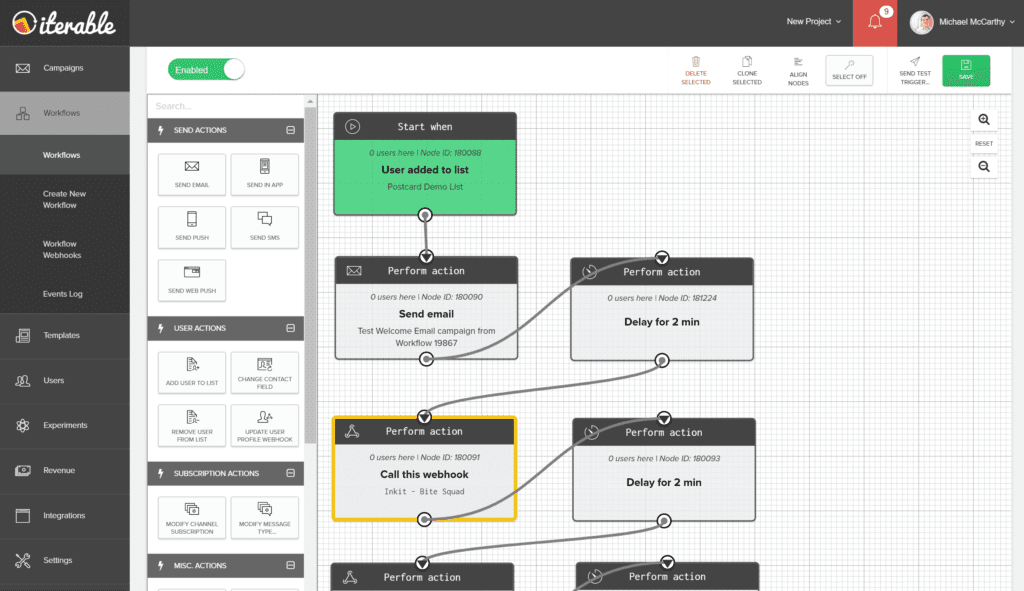Annual marketing budget planning can be tricky. You’ve got to predict ways to stay on the cutting edge, incorporate emerging innovations, stand out from your competitors and—the big one—yield a return on investment.
Direct mail marketing may be the last channel on your mind when strategizing for the upcoming year, but ignoring this channel in 2019 could be a huge mistake.
More and more top e-commerce brands (from Stitch Fix to Wayfair to FrameBridge) are embracing modern direct mail marketing in the Digital Age, and there are a ton of convincing reasons why.
Before we get into the top 5 reasons to add direct mail to your marketing budget, let’s explain a bit about how direct mail automation works.
What Is Automated or Artificial Intelligence Direct Mail Marketing?
We’re certainly not advocating that you take an old-school approach to direct mail marketing in 2019.
Direct mail gets a bad rap as a tedious, time-consuming and ineffective channel due to the traditional process it once entailed. A marketer’s only option used to be to create expensive, poorly targeted, standalone direct mail campaigns.
This was because printers required minimum batch sizes and extensive lead times, and messy logistics made it impossible to send relevant, personalized marketing messages in real time. Modern direct mail is nothing like this.
Referred to as direct mail automation, triggered direct mail and even artificial intelligence direct mail, today’s direct mail marketing works a lot like digital. It’s a data-driven, behaviorally-triggered and measurable channel.
You can trigger personalized direct mail—at virtually any scale—right from Iterable’s platform using Inkit’s direct mail integration. Simply create your mailers in Inkit’s plug-and-play builder and add postcard triggers in Iterable’s Workflow Studio.
Pro tip: Make sure your postcards include trackable discount codes, QR codes, reply codes, personalized URLs (PURLs) or unique landing pages. This way you can easily funnel performance data back into the app.
As you can see, when you use Iterable + Inkit, direct mail marketing works very similarly to email automation.


Send email and direct mail from a single platform using Iterable’s integration with Inkit.
Why You Should Add Automated Direct Mail to the Marketing Budget
So now you know that modern direct mail is pretty easy in practice, but how is it going to help you stay on the cutting edge in 2019? Incorporate emerging innovations into your marketing plan? Stand out from your competitors? And yield ROI?
As you evaluate your marketing budget and plan ad spend, you may gravitate toward email, digital ads, boosted social posts and new innovations like virtual reality to accomplish all of these things.
But we think direct mail is going to be huge for cross-channel marketers in 2019 and here are five reasons why.
1. Direct mail is the top performing direct response channel
Direct mail is a $44.2 billion industry. And marketers aren’t just spending money on direct mail; they’re making money.
Direct mail response rates beat all digital channels combined by a landslide. The average response rate for direct mail is 3.7%, compared to just 2% for mobile and 1% for email and social.
And these response rates yield significant ROI. U.S. advertisers earn $2,095 for every $167 spent per person on direct mail. This is a 1,300% ROI!
And consumers don’t appear to be tiring of direct mail any time soon. In fact, consumers use paper coupons at a higher rate year after year.
Direct mail’s effectiveness is nothing new, but e-commerce marketers are just beginning to take notice as innovative direct mail apps add accessibility and allow for cross-channel integration.
Even Amazon is rumored to be testing the waters of AI direct mail, having sent a debut holiday toy catalog this year. Jump on this channel early before your competitors do.
2. You might lose 25% of your email list next year
That sounds bleak, doesn’t it? Sorry, but it’s true. Many, many brands will lose 1 in 4 email addresses due to list churn in 2019.
But you may not fare as badly if you’re using Iterable, which allows you to spot and respond to signs of disengagement quickly, preventing channel fatigue.
If your customers are tiring of seeing you in their inbox or all over their screens, you can trigger a postcard.
Are you wondering if showing up in the mailbox might be just as annoying for customers who are burning out on marketing messages? It won’t be.
Consumers enjoy receiving relevant mail, making triggered direct mail an excellent secret weapon when it comes to re-engagement.
In fact, we’ve seen Inkit customers net double-digit response rates (as high as 18%) from well-timed re-engagement postcard automation. Check out this post for more on knowing when to send direct mail vs. email.
3. Direct mail clears through the digital clutter
Consumers in your target market will probably receive about 121 emails a day in 2019. Unless everyone on your list is super engaged with your brand, chances are some recipients won’t even take the time to read your expertly crafted subject lines. Marketers often have to work incredibly hard to make sure their messages rise above the digital noise.
By contrast, 6 in 10 consumers actually look forward to checking their mail everyday. Nearly 80% of millennials say they engage with direct mail as well as 35% of early adopters, those likely to be the first to adopt a new technology.
Of course, this is not to say you should abandon or even cut back on digital channels in 2019. On the contrary, direct mail can help you connect with customers offline to bring them back online. Always transition your direct mail reader to an online touchpoint.
For example, the aforementioned Amazon holiday toy catalog uses QR codes to direct right to product pages online.
4. Direct mail fosters a brand-to-human connection
Direct mail gives you something in your marketing plan that digital lacks: tangibility. With direct mail automation, you can reach out to your customers on a whole new level—offline.
This can be particularly important for e-commerce brands that are unable to physically interact with customers in the real world, aside from unboxing experiences.
And this isn’t just a theory. Direct mail actually elicits a much stronger emotional response than digital marketing. Indiana Digital found that consumers experience rising oxytocin levels when they receive paper coupons, according to Forbes.
And according to a study by UK Royal Mail, 60% of consumers find direct mail has a lasting impression resulting in better brand recall.
Take a look at your customer lifecycle and review stages where you think your customers need an extra, personal touch. These are ideal times to reach out with a postcard. Popular use cases for this are welcome postcards, thank you postcards and loyalty gifts.
5. Direct mail is cost-effective with Iterable
Many marketers will shy away from direct mail in 2019 because of the cost. All of the benefits of direct mail listed above make it a more expensive channel than digital. It’s a physical object that must be printed, postmarked and mailed, and this can add up.
However, direct mail automation is more cost-effective than ever, primarily because the targeting has improved significantly. You no longer have to purchase direct mail lists, for example, because you have built-in audiences that you can segment and refine within the Iterable platform.
If you take a truly cross-channel approach, and we recommend this, you can save even more because you can test concepts in email and social before investing in direct mail.
You might trigger direct mail only to consumers who fail to open an email, for example. You may also gather data indicating segments that respond better to direct mail over another channel and vice versa.
You will also be able to track direct mail performance and A/B test mailers using Iterable with Inkit, allowing you to optimize direct mail for the best performance.
How to Add Triggered Postcards to Cross-Channel Workflows
Are you ready to add triggered postcards to your customer journey, or would you like to learn more about where direct mail fits in a cross-channel workflow?
Click here for a live demo of direct mail automation with Inkit. We would be happy to help you set up an initial postcard test campaign as you evaluate whether direct mail automation should be part of your 2019 marketing budget.





























